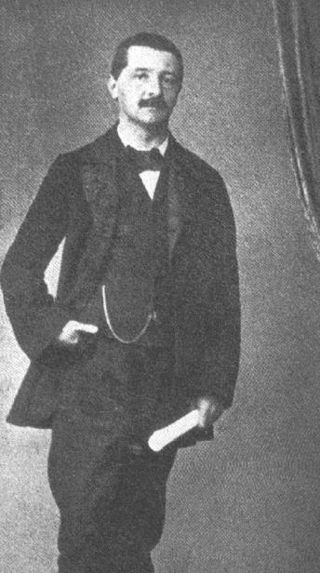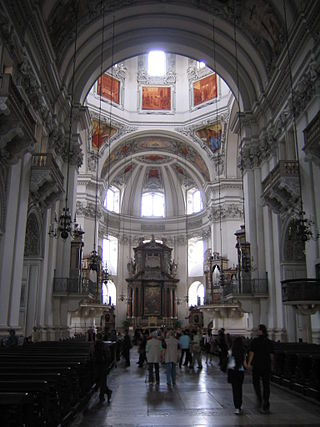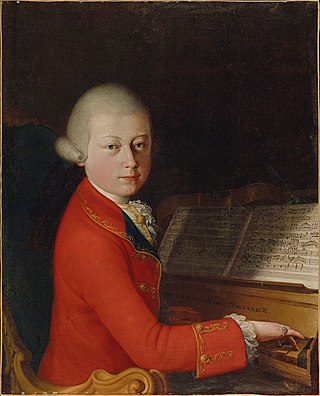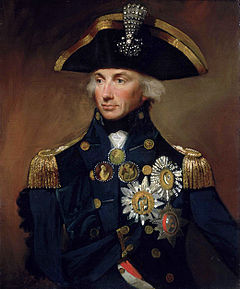
Great Mass in C minor, K. 427/417a, is the common name of the musical setting of the mass by Wolfgang Amadeus Mozart, which is considered one of his greatest works. He composed it in Vienna in 1782 and 1783, after his marriage, when he moved to Vienna from Salzburg. The large-scale work, a missa solemnis, is scored for two soprano soloists, a tenor and a bass, double chorus and large orchestra. It remained unfinished, missing large portions of the Credo and the complete Agnus Dei.

Missa in tempore belli is a setting of the mass by Joseph Haydn. It is catalogued Mass No. 10 in C major. Known also as the Paukenmesse due to the dramatic use of timpani, it is one of the most popular of his fourteen mass settings. The autograph manuscript contains the title "Missa in tempore belli" in Haydn's handwriting.
The Mass No. 13 in B-flat major, Hob. XXII/13, was composed by Joseph Haydn in 1801. It is known as the Schöpfungsmesse or Creation Mass because of the words "qui tollis peccata mundi" in the Gloria. He recycled music from Adam and Eve's final duet in The Creation, a fact which scandalized Empress Maria Theresa so much that she ordered Haydn to recompose that passage for her own copy.

The Missa solemnis, WAB 29, is a solemn mass composed by Anton Bruckner in 1854 for the installation of Friedrich Mayer as abbot of St. Florian Monastery on 14 September 1854.

The Missa Sancti Bernardi von Offida is a mass in B-flat major by Joseph Haydn, Hob. XXII:10, Novello 1, was written the same year as the Missa in tempore belli (1796), and it "may have been the first mass Haydn wrote after his return from England." Yet it may also have been the second. It is usually given as Haydn's ninth setting of the mass, though its Hoboken number is XXII:10. This mass was written in honor of St. Bernard of Offida, a Capuchins who devoted himself to helping the poor; a century after the friar's death, he was beatified by Pope Pius VI.

The Missa Cellensis in honorem Beatissimae Virginis Mariae in C major by Joseph Haydn, Hob. XXII:5, Novello 3, was originally written in 1766, after Haydn was promoted to Kapellmeister at Eszterháza following the death of Gregor Joseph Werner. The original title as it appears on the only surviving fragment of Haydn's autograph score, that has been discovered around 1970 in Budapest, clearly assigns the mass to the pilgrimage cult of Mariazell, Styria. Until that discovery, the work was known as Missa Sanctae Caeciliae, or in German Cäcilienmesse, a title probably attributed to the mass in the 19th century. Whether the alternative title refers to a performance of the piece by the St. Cecilia's Congregation, a Viennese musician's fraternity, on some St. Cecilia's day, as has been suggested, remains speculation.

The Missa brevis in G major, K. 140, K3 Anh. 235d, K6 Anh. C 1.12, was probably composed by Wolfgang Amadeus Mozart shortly after returning to Salzburg, in March 1773, from his third trip to Italy.
Austrian composer, Michael Haydn's Missa Hispanica or Missa a due cori, Klafsky I:17, MH 422, was presumably written for Spain, but there is no evidence of its ever having been performed there during Haydn's lifetime. The mass is scored for 2 oboes, 2 bassoons, 2 horns in low C, F and G, 2 trumpets in C, timpani, strings, basso continuo, SATB soloists, and two mixed choirs.
Michael Haydn completed the Missa in honorem Sanctae Ursulae, Klafsky 1:18, MH 546, on August 5, 1793, probably for use at the ceremony in which Ursula Oswald, the daughter of a friend, professed her religious vows at the Benedictine Abbey of Frauenwörth Chiemsee. Because of that fact, the Mass is sometimes known as the Chiemsee Mass.
Missa Sanctissimae Trinitatis in A minor, ZWV 17, is the a vocal-instrumental sacred work, written by Czech Baroque composer Jan Dismas Zelenka. It was completed in 1736 as the first of five high masses he wrote in the last ten years of his life.

The Missa solemnis in C major, K. 66, is a mass composed by Wolfgang Amadeus Mozart in 1769. It is scored for SATB soloists and choir, violins I and II, viola, 2 oboes, 2 horns, 2 clarini, 2 trumpets and basso continuo.

The Missa brevis in D major, K. 194/186h, is a mass composed by Wolfgang Amadeus Mozart and completed on 8 August 1774. It is scored for SATB soloists, SATB choir, violin I and II, 3 trombones colla parte, and basso continuo.

The Missa brevis No. 7 in C major, K. 258, is a mass composed by Wolfgang Amadeus Mozart in 1776. It is scored for SATB soloists, SATB choir, violin I and II, 2 oboes, 2 clarini, 3 trombones colla parte, timpani and basso continuo.

The Missa longa in C major, K. 262/246a, is a mass composed by Wolfgang Amadeus Mozart in May 1776. Other sources claim it was composed in May 1775. It is scored for SATB soloists, SATB choir, violin I and II, 2 oboes, 2 horns, 2 clarini, 3 trombones colla parte, timpani and basso continuo.

Mozart's Mass in G major, K. 49/47d), is his first full mass. It is a missa brevis scored for SATB soloists and choir, violin I and II, viola, and basso continuo.
Missa Sancti Nicolai, Mass No. 6 in G major, Hob. XXII/6, also known as the Nicolaimesse, is a mass by Joseph Haydn, composed around 1772 and revised in 1802.
The Missa Votiva is a mass composed by the Czech Baroque composer Jan Dismas Zelenka in 1739, Dresden. The Missa Votiva is about seventy minutes long, and its twenty parts range from forty-five seconds to over seven minutes in length.

Missa cellensis refers to two masses by Joseph Haydn:

Mozart Mass K. 139 is a 45-minute classical studio album on which Mozart's Waisenhaus-Messe is performed by Gundula Janowitz. Frederica von Stade, Wiesław Ochman, Kurt Moll, the Chorus of the Vienna State Opera and the Vienna Philharmonic Orchestra under the direction of Claudio Abbado. It was released in 1976.

Missa Sanctae Caeciliae in G major, ZWV 1, is a mass for voices and orchestra by Jan Dismas Zelenka. It was completed in 1711 as his first work for the Dresden court.











